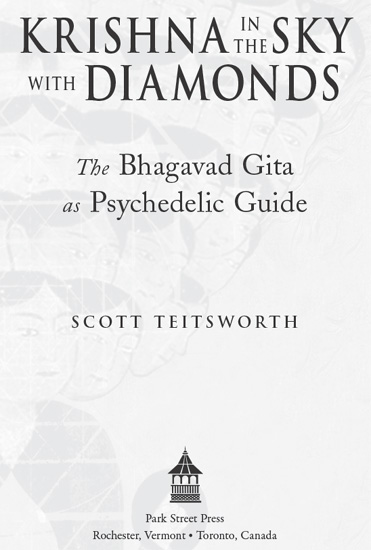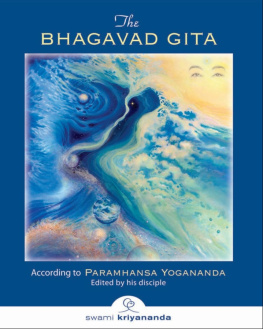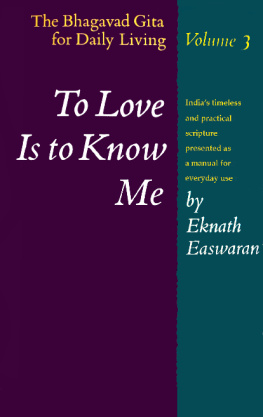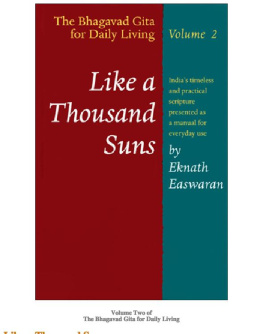

In gratitude to Guru Nitya Chaitanya Yati, superb teacher of the Bhagavad Gita, lifelong friend, and continuing inspiration

PROLOGUE
At the outset of the Bhagavad Gita, a man named Arjuna finds himself on the verge of a supremely challenging battle involving everything he holds dear. No matter who wins, he can foresee only madness and destruction as the outcome. His instinct, even though he is a famous warrior, is to turn and flee. He doesnt even want to think about it any more. But his chariot driver, Krishna, insists that he stand his ground. He tells him, You only want to run away because you dont understand this situation and your place in it. Stay here with me and I will teach you.
Certain he is trapped in a situation with only disastrous options, Arjuna agrees, and the two enter a deep dialogue. They sit right in the middle of the battlefield, with swords clashing and arrows whizzing all around them. It is very important that they can have this seemingly impossible conversation without any need for protection. It tells us in pictorial language that the Gitas teaching is focused on how to live in this world, right in the thick of things, and is not about finding a better life somewhere else. In the final analysis there is nowhere to hide, nowhere to escape to.
After a lengthy instruction, Arjunas fears are calmed and his intelligence is satisfied. All his questions and doubts have been resolved. Yet he has one more request. Dear Krishna, it all makes sense to me now, and I appreciate that very much. But I would like to have a direct experience of what you have described to me. Intellectual understanding is wonderful, but I need to feel it in my heart too. In my very bones. Is there some way for me to know this truth more intimately?
Krishna answers, Yes, certainly. Im glad you asked. He mixes a special decoction known as soma, brewed from herbs and mushrooms, and in a sacred ceremony with a longstanding tradition he serves it to his disciple.
The soma he drinks blows Arjunas mind wide open, revealing the underlying oneness of all existence to him. The impact is searingly direct and undeniable. It is as though a level of reality Arjuna had utterly forgotten was at last restored.
No matter how fine a teaching might be, it is only words and their associated concepts until it is converted by the learner into a direct experience. Chemists study up-to-date theories about the elements and their properties, but they dont become true chemists until they handle actual chemicals and start mixing them together. Before that they are merely students. Teachers first learn the principles of teaching in school, but they are only in training until they go out and stand up in front of a classroom. This is a common progression for nearly all expressions of dharma, a persons true calling, including in spiritual matters. The time has come in Arjunas unfoldment to move from theory to practice, to put his knowledge into action via realizationin other words, to make the wisdom he has imbibed real. The soma ceremony impels him to do just that.
The inner nature Arjuna discovers is our inner nature, too. It is charged with intense joy and energy, but we have lost touch with it. Abstractly believing that we are an integral part of a coherently interconnected universe is well and good, but knowing it as a living reality sweeps away layer after layer of illusion, of false speculation. Soma peels back the veil our own minds have woven and restores us to harmony with our true being. There is no greater bliss on Earth.
One likely result of such an overwhelming experience is that we do not have any way to comprehend it, to wrap our minds around it. What we face transcends our definitions, no matter how bountiful those might be. But to live a viable life as an embodied being we need to integrate this new awareness into our knowledge base. Krishna will spend the rest of the Gitaseven more complete chaptershelping Arjuna to do just that. When his integration is finally accomplished, Krishna lets him know that he has become a truly independent soul, capable of making his own expert decisions. He no longer needs to be subservient to any person, system, or idea. He is free.

INTRODUCTION
The Bhagavad Gita is one of the most important of the ancient writings of the human race. It forms part of the Mahabharata, probably the worlds longest epic, which gleans the cream of the wisdom of a large and disparate group of thinkers in what is today northern India. Of uncertain date, the earliest changeover from oral to written form is likely to have been roughly contemporary with the Buddha, around 500 BCE. Chapter XI of the Bhagavad Gita, titled Vivarpa Darana Yoga or The Unitive Vision of the Absolute, is one of the most eloquent descriptions of a complex psychedelic experience ever recorded. The present book is intended to decode its archaic language and symbolism to clarify the helpful intentions of its anonymous author, known only as Vyasa (Writer).
In the Gita, as it is affectionately called, there are just two main charactersthe seeker Arjuna and his guru Krishnaplus a narrator, Sanjaya. Krishna is a human being, but in the reverential attitude of India a guru is also a living incarnation of the Absolute, the supreme principle, that which leaves nothing out. In Vedanta, the philosophical system of the Gita and its close cousins the Upanishads, everyone and all things are the Absolute in essence, and the seekers path, such as it is, is to come to know this truth. It is a path that begins and ends right where you are.
Arjuna and Krishna are talking on the battlefield in the middle of a great war. Some people are bothered that the Gita unfolds in such a discordant environment, imagining that a scripture should be set in a garden of paradise. But life is filled with conflicts, great and small. The Gitas message is that we are sure to face difficulties throughout our life, but we can learn to manage them well. It is not about how to avoid problems by making an escape or by holding on to a single predetermined viewpoint.
The setting of the battlefield also tells us that the way to peace is not through rearranging the outside world. The world, with its complex problems, will almost certainly not be fixed by us no matter how hard we try. But we are eminently capable of major improvements to ourselves, especially given some expert guidance. Life is a struggle and a fight much of the time, and no one has ever succeeded in taming it for long. We need to find solid ground within ourselves, so that whether the winds blow fair or foul we will not be knocked over. Paradoxically, once we heal ourselves and become stabilized we can begin to have a beneficial impact on our surroundings, but if we confront the worlds ills from a discordant position, our efforts will be plagued with unintended and often tragic consequences.
SOMA
The Bhagavad Gita presents a detailed scientific psychology lightly clothed in the type of religious-sounding narrative in favor at the time. Being a textbook on what is required to produce a truly liberated adult human being, it does not impose any rigid structure or set of rules to follow. Its goal is to teach people how to make their own decisions based on their deepest nature, because, while that nature is constant and dependable, circumstances are forever in flux. What is appropriate in one instance may be a deadly mistake in another. A truly awake human being will know how to act well without having to seek direction from any scripture or law library.
Next page








